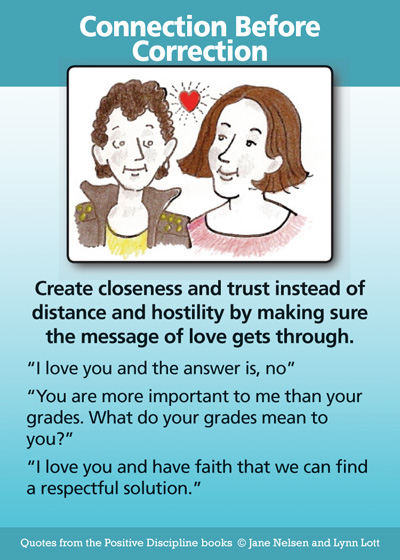Connection Before Correction is one of my all-time favorite Parenting with Positive Discipline mantras. I believe these are words to live by both in the moment of dissatisfying behavior, and in the long run as a foundation for any relationship.
Several years ago I began to feel like a nag to my then 11-year-old son so I tracked the content of our interactions. On one side of a paper, I tracked the “correction” interactions. On the other, I tracked the “connection” interactions. After only one day the corrections more than doubled the connections. No wonder we were both annoyed with me!
When children feel strongly connected to you (they feel loved, valued, and understood), they are simply more open to your influence.
It’s true for adult relationships, too. Think of someone who really likes or loves you, respects you, understands and listens to you. How open are you to that person’s influence?
On the other hand, how open are you to someone who’s frequently telling you what to do, how you’re wrong, and what you need to change?
If you’re guilty of jumping to correct undesirable behavior without connecting first, it might be for one or more of the following reasons:
- It’s faster and more efficient to get right to the point
- You believe the other person values your candor
- You’re busy and have more important things to do
- You feel the behavior needs to be corrected immediately
Sometimes these reasons hold. However, when we focus on correcting behavior all the time without investing in the relationship, at some point, the relationship degrades and the correction falls on deaf ears (or even worse, defiant ones.)
So if you’re a “get it done and move on” kind of person, I invite you to pay attention to your own tally, and try out these three easy ways to practice Connection Before Correction:
- Give Hugs. So simple and effective! Hugs (and any form of physical affection) release oxytocin, a “feel good” neurochemical, into the brain which helps the child calm down and be more receptive.
Correction: “I’ve asked you five times to put away your toys. Do it now!”
Connecting first with a hug: “Oh, come here, buddy (Big Hug). I see toys that need to be put away. Do you need help or can you handle it alone?
- Acknowledge Feelings / Empathize. Acknowledging feelings can help children learn that feelings are always OK, but how we act on those feelings is not always OK. Empathy also helps children feel understood, which again helps them feel more calm and receptive.
Correction: “You cannot grab things without asking first! Give that toy back to your brother!”
Connecting first by acknowledging feelings: “I can tell that you really want to play with that toy, it’s really cool! And, we have to ask first. Let’s try again.”
- Say, “I love you.” Start with these three words (spoken in a warm, heartfelt way), and whatever comes next feels softer.
Correction: “No, you cannot have ice cream before dinner, so stop asking!”
Connecting first with I love you: “I love you, and the answer is no.” When delivered with compassion and kindness, the “no” doesn’t feel quite so bad.
These three examples all use Connection Before Correction in the moment of undesirable behavior. However, this mantra is most powerful when connection defines the relationship long term, not just in moments where parents want compliance.
You’ve probably heard the quote, “I don’t care what you know, until I know that you care.” I don’t know who said it first, but it sure rings true in my experience as a parent (and as a partner and professional, too.)
So make it a habit to play, laugh, listen, hug, empathize, and share your love with your child in good times and bad. That strong, connected relationship will be the foundation for the future, when your child is a teen or young adult, and you pray that your influence still counts!
Join us and take the 52 Parenting Tools in 52 Weeks Challenge. This is a fun way to stay focused on Positive Discipline in your home.
We hope you will participate and share by posting comments about your experiences using Positive Discipline Tools for Parents.
Click Here to get a copy of the Positive Discipline Parenting Tool Cards. It would also be helpful to read a
Positive Discipline Book!
The great thing about this challenge is that you can start at any time. It doesn’t matter which week you start with, just jump on in and join the challenge!


No Comments yet!